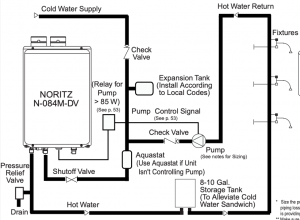Have you ever turned on the faucet to take a relaxing hot shower, only to be hit by an unpleasant stream of cold water?
It’s safe to say we’ve all experienced the inconvenience of having to wait for hot water to arrive at the faucet or shower — most of us every morning. You’ve probably grown accustomed to waiting several seconds or even a minute or two, depending on the distance to your bathroom or kitchen from your water heater in your basement, garage or utility closet on the opposite side of the house. The longer that distance, the longer the wait, the bigger the annoyance.
So why does the water coming from your “hot”-water faucet or shower run cold at first before finally turning hot? When that outlet was last turned on, hot water flowed through the pipes, right?
But once the outlet was shut off, the remaining warm water in the pipes did not return to the water heater for reheating. Instead, it stayed in the pipes and eventually turned cold. When the outlet was next turned on, this resting cold water exited the pipes first, ahead of the incoming hot water from the water heater.
Not only is this inconvenient (and downright uncomfortable if you’re standing in the shower), but a typical American home annually wastes thousands of gallons of perfectly usable potable water down the drain, thanks to lengthy wait times at hot-water outlets in the bath and kitchen.
So what’s the solution? Is it possible to get truly “instantaneous” hot water? Yes, with a hot-water recirculation system that delivers hot water with virtually no wait time.
What Is a Hot-Water Recirculation System?
A hot-water recirculation system delivers hot water to a faucet, shower or appliance in seconds, eliminating the usual water-wasting wait. The system does so by recirculating the water that remained in the pipes and eventually turned cold, back to the water heater, through either the cold-water line or a dedicated return line.
One type of recirculation system — and the focus of this blog — is a closed-loop, pump-assisted, hot-water recirculation system.
A recirculation pump can operate 24/7. But the energy savings would be nonexistent if the external circulator were always on and continuously recirculating hot water.
The most efficient type of hot-water recirculation system is an on-demand type that operates on the push of a button.
The most efficient “traditional” recirculation method would use a combination of both a temperature sensor and a timer to activate the system.
Recirculation System with a Dedicated Loop
Some recirculation pumps can serve as a separate, add-on component that uses a dedicated pipe loop for hot-water recirculation.
Here’s how a recirculation pump with a dedicated return line works:
 Hot water flows from the water heater and passes near each hot-water outlet.
Hot water flows from the water heater and passes near each hot-water outlet.Recirculation System with an Integrated Pump
Some hot-water recirculation pumps are built into the water heater itself. An integrated recirculation pump is ideal if your home lacks a dedicated return line, and you want to avoid the cost of adding one.
Another option is to purchase a “crossover kit” that is sold with the water heater and acts as a substitute for a return line.
Instead of wasting energy by having hot water flow through the system continuously, some water heaters have an integral display on the front of the unit that allows homeowners to program the recirculation system to operate at specified times.
In conclusion...
Whether you choose to install an external recirculation pump or go with a fully integrated system, the benefits for both are clear. A hot-water recirculation pump eliminates the need to wait for hot water by recirculating the water through your plumbing system, keeping hot water flowing and ready for the moment someone turns on the faucet or shower.
Hot-water recirculation dramatically reduces water waste. With time and temperature sensors, hot-water recirculation pumps can control when the recirculation kicks on, ensuring that energy is not constantly being wasted.